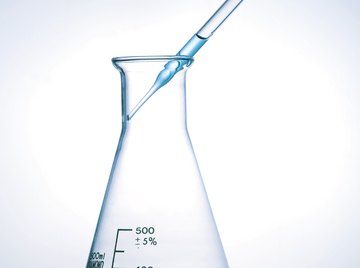
A solution is a mixture of compounds whereby one of them – the solute – is distributed throughout the other, known as the solvent. The solvent is always the compound that forms the largest part of the mixture, and in the bulk of real-world situations, the solvent is water. The properties of a solution change with the solute concentration, so chemists need concentration units to measure it. The most important concentration unit is molarity, which is the number of moles of solute per liter of solution. Molarity is denoted by a capital M, and M in chemistry means the following:
Molarity (M) = (moles of solute) ÷ (liters of solution).
To calculate the number of moles of a solute, you need two pieces of information, which you may have to infer from other data. The first is the chemical formula of the solute, and the second is the mass of the solute. You then calculate molarity by measuring the volume of the solution, converting that to liters and dividing this number into the number of moles.
What Is a Mole?
Furry burrowing animals aside, the mole is one of the central measurement units in chemistry. It's based on Avogadro's number, which is 6.02 x 1023. This is the number of atoms in a sample of carbon-12 that weighs exactly 12.000 grams. The same number of particles of any other compound is a mole of that compound. One mole of any compound has a characteristic mass in grams, which happens to be exactly the same as its atomic mass in atomic mass units (amu). For example, the atomic mass of hydrogen is 1.008 amu, so a mole of hydrogen weighs 1.008 grams.
You can look up atomic masses in the periodic table, and you can calculate the molecular mass of a compound based on its chemical formula. Once you know the atomic mass of a compound, you immediately know the mass of a mole of that compound (molar mass). If you have a sample of the compound on hand, just weigh it and divide by the molar weight to find the number of moles you have.
Example: A sample of sodium hydroxide (NaOH) weighs 32 grams. How many moles is this?
From the periodic table, you find the atomic masses of sodium, oxygen and hydrogen to be 22.990, 15.999 and 1.008 amu respectively. Rounding to a whole number, their molar masses are 23, 16 and 1 grams respectively. Add these together to get the molar mass of sodium hydroxide, which turns out to be 40 grams. Divide this number into the amount you have on hand to find the number of moles:
32 g/40 g = 0.8 moles.
How to Find Molarity
As long as you have a way of measuring the mass of a solute, you can calculate its molarity by measuring the volume of the solution. Be careful here, because molarity is always expressed as moles/liter, so if you measure volume in any other units, you have to convert to liters. Here are some conversion factors that you'll find useful:
1 liter = 0.001 cubic meters = 1,000 milliliters = 0.264 U.S. gallons = 33.81 fluid ounces.
An Example
You pour 12 grams of salt (NaCl) into a beaker containing 20 ounces of water. What is the molarity of salt in the solution?
You can solve this problem in three easy steps:
Rounding to one decimal place, the mass of one mole of sodium (Na) is 23.0 grams and that of chlorine (Cl) is 35.5 grams, so one mole of NaCl has a mass of 58.5 grams. You have 12 grams, which equals 12/58.5 = 0.21 moles.
If 33.81 ounces is the same as 1 liter, 20 ounces equals 20/33.81 = 0.59 liters.
Divide the number of moles of NaCl by the volume of the solution to get molarity.
0.21 moles ÷ 0.59 liters =
0.356 M.
References
About the Author
Chris Deziel holds a Bachelor's degree in physics and a Master's degree in Humanities, He has taught science, math and English at the university level, both in his native Canada and in Japan. He began writing online in 2010, offering information in scientific, cultural and practical topics. His writing covers science, math and home improvement and design, as well as religion and the oriental healing arts.
Photo Credits
Photos.com/Photos.com/Getty Images
